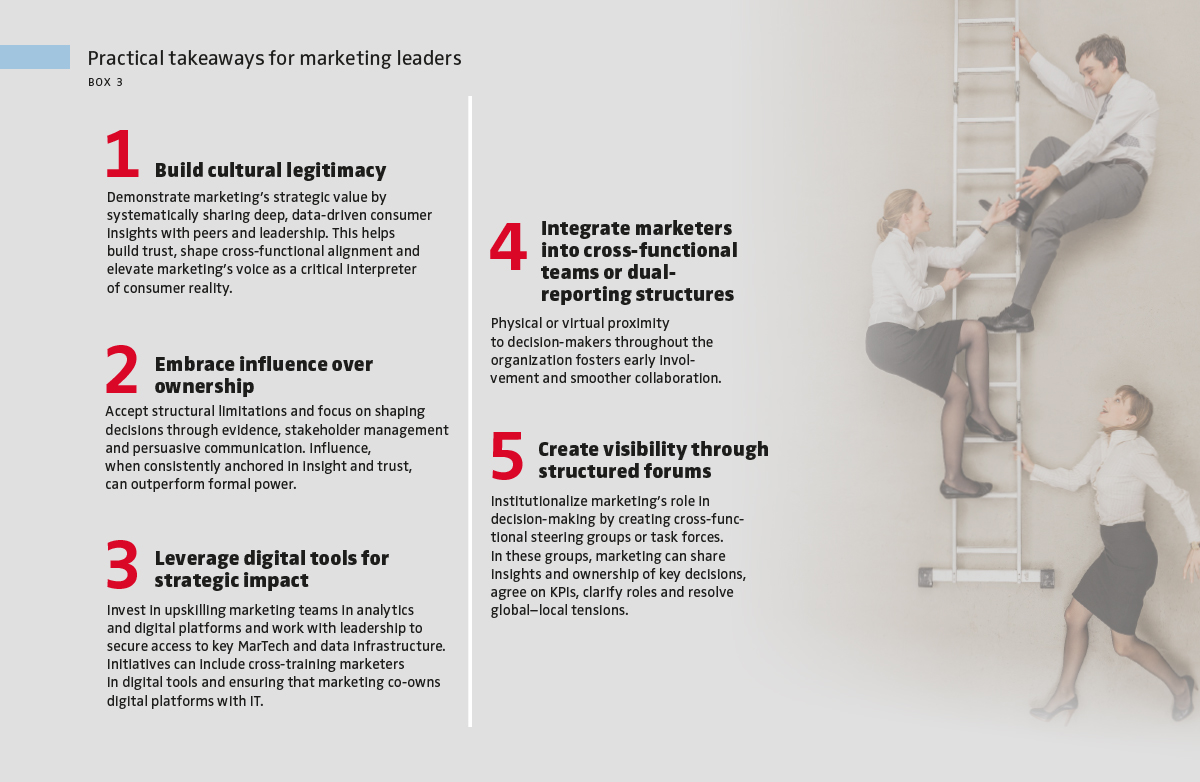 Download
Download
Marketing as a Silo-Breaker: How to Turn Organizational Constraints into Opportunities for Strategic Influence
Marketing textbooks often portray the chief marketer as the master of the “4 P s” (product, price, place and promotion), controlling all levers of the marketing mix. However, recent research suggests that few companies give marketing a Growth Champion role with line authority over virtually all marketing decisions. For most of today’s organizations, marketing’s role is narrower, focusing primarily on communications (as MarCom Leaders) or even just providing support to other functions (Service Providers). This raises a critical question: How can marketing drive growth and champion the consumer when it doesn’t control all four Ps?
Using insights from in-depth interviews with 16 senior marketing executives from consumer goods and electronics companies, we take a closer look at this challenge and identify four key themes that show how marketers can excel when direct authority is limited. Together, these insights provide a playbook for turning organizational constraints into opportunities for strategic influence, cross-functional partnership and real business impact.
Key themes for today’s marketing organizations
Our study found four key themes that describe how marketing can gain influence in companies without having full decision authority and control over all classic marketing levers (see Figure 1).
> Hybrid and layered structures navigate global-local tensions
The prototypic model in which marketing controls all four Ps and is strategically central can still be found. However, nowadays, this model is more often adopted by smaller and more nimble organizations, which may be digital-first. At such companies, marketing leaders control everything from product to packaging to pricing, enabling a rapid response to market trends. Marketers at large companies may admire Growth Champion models but find they are often infeasible at scale due to organizational complexity, cross-functional dependence and distributed decision rights. Large companies are typically only able to employ the Growth Champion model in exceptional cases, such as digital innovation units, direct-to-consumer businesses or rapid-response teams activated during crises like COVID-19. In these contexts, organizations temporarily empower small, agile squads, often by combining talent from marketing, product and tech to bypass traditional departmental silos and enable faster decision-making and greater cohesion.
Most large companies in our sample operate with multiple marketing organization types. Growth Champion, Marcom Leader and Service Provider models often coexist across geographies, business units or channels. In practice, in many companies, local marketers hold authority over pricing, promotions and assortment, acting as mini-general managers accountable for business results. In parallel, global brand teams may design the overarching brand vision but have limited say in local market execution, instead offering guidance, toolkits and innovation roadmaps, more akin to MarCom Leaders or Service Providers.
The key to success lies in balancing global consistency with local flexibility. Leading companies address this by establishing joint planning processes, shared KPIs and clear escalation paths, enabling local teams to adapt to global strategies while maintaining alignment and brand integrity.
Such complexity also has implications for talent development. Rotation between global and local roles is a potential strategy for broadening marketers’ perspectives, building empathy and developing leaders who can bridge strategy and execution. Institutionalizing such rotations and cross-functional assignments creates more versatile talent and embeds a culture of collaboration and mutual understanding. This is essential for navigating the complexities of hybrid and layered marketing organizations.
> Culture trumps structure in determining marketing power
Companies’ formal organizational charts often fail to capture the true distribution of power. Instead, the cultural attitude toward marketing, which determines whether it is seen as a strategic partner or an executional helper, determines how much influence it has.
A company’s approach to marketing goes beyond formal reporting lines, relying instead on widely shared beliefs and routines as well as informal norms that give marketing a natural seat at the strategy table. Such a pro-marketing culture is visible through shared language, such as “customer-centricity” or “brand guardianship”; regular cross-functional rituals, such as joint planning sessions, consumer immersion days or shared KPI reviews; and ingrained processes that bring marketing into early-stage product or innovation decisions. In this context, culture should not be underestimated. While organizational charts determine authority, it is culture that shapes access, credibility and timing. Even the most sophisticated structures fail if a company’s cultural norms do not support marketing’s strategic role.
When a company has a pro-marketing culture, marketing is not just consulted for campaigns; it becomes the guardian of meaning across the organization, influencing product formulation, digital UX and even HR-led culture initiatives.
For management, shaping such a culture means more than restructuring. It involves systematically promoting consumer insight as a driver of decisions, celebrating marketing-led successes, investing in marketing training across functions and creating platforms where marketing’s perspective is routinely heard and valued.
> Collaboration is a core competency in low-authority environments
In MarCom Leader and Service Provider marketing organizations, marketing rarely controls strategic decisions. Leading effectively depends on how well marketers collaborate across boundaries – that is, their ability to influence laterally, which requires strong collaboration, negotiation and emotional intelligence.
Marketers in these settings are judged by how well they enable other teams, not by their ability to enforce direction. Their success hinges on soft skills: listening, influencing and strategically managing stakeholder dynamics without top-down authority. The best marketers position themselves as integrators, helping R&D, finance, creative and regional teams align around shared outcomes.
Informal trust becomes key for marketers. In Service Provider models, formal authority may be absent, but marketers who are reliable, prepared and insight-driven earn the right to shape direction. Such teams often rely more on coalition-building than on command chains, influencing decisions not through hierarchy but by consistently being the most informed and strategically valuable voice in the room, earning their place at the decision-making table through credibility.
Job shadowing and cross-functional rotation are recommended to build mutual understanding and credibility. A marketing leader in our sample, for example, explicitly recommended that marketers rotate through sales, product and customer-facing roles. This rotation builds mutual understanding, breaks silos and helps marketers gain credibility by learning to speak the operational language of other teams.
Even when marketing lacks formal control over all elements of the classic 4 Ps, it can play a decisive role in driving growth.
> Digital transformation and the rise of AI are reshaping marketing’s role but amplifying ambiguity
The widespread adoption of digital platforms and AI tools is changing how marketing operates. Although these technologies enhance data accessibility and accelerate analytical capabilities, they simultaneously create new tensions around responsibility and decision-making authority. Marketing relies on digital technologies but doesn’t own them; in many companies, AI and MarTech platforms for handling customer relationships, customer data or campaign tools are managed by IT or analytics, leaving marketing with less control, although they are expected to use these tools to drive outcomes (such as growth or engagement).
This scenario creates dependency without control: marketing departments are expected to act quickly and personalize at scale, but they are reliant on others for tool access or workflow design. For example, interviewees reported that marketing could use AI to generate content or segment consumers, but IT departments set the boundaries of what was allowed, limiting both creativity and speed. This separation can also create skills gaps: marketing may lack the technical fluency to fully exploit available data, while IT may not grasp the nuances of brand strategy or customer experience.
However, some organizations overcome these barriers through cross-functional digital integration. An interviewee from a global premium beauty company provided a strong example. In their company, marketers are embedded alongside product and IT specialists, share responsibility for MarTech platforms and are cross trained in digital tools. This collaborative approach enables rapid adaptation and data-driven decision-making, while also reducing friction between teams. As a result, marketing regains strategic relevance, as it can deliver on digital transformation goals more effectively and ensure that AI is thoroughly integrated into processes rather than being used merely as an add-on. This approach can serve as a model for other organizations seeking to maximize marketing’s impact in a technology-driven environment.
Don’t mourn limited authority - act as a silo-breaker
Today's marketing organizations are structured differently than in the past, but they are by no means powerless. This study demonstrates that even when marketing lacks formal control over all elements of the classic 4 Ps, it can play a decisive role in driving growth if it excels in influence, integration and value creation across the organization.
For marketing to thrive under constraint, organizations must go beyond structural tweaks. They should actively shape a culture that values consumer insight, invests in cross-functional collaboration and empowers marketers to act as orchestrators of value creation, even in the absence of formal authority. Box 2 shows the critical organizational support this approach requires, and Box 3 offers clear guidance for marketing leaders.
For marketing leaders, the takeaway is clear: success in today’s environment isn’t about controlling every lever but about orchestrating collective momentum toward growth. By moving beyond the four Ps and focusing instead on decision influence and collaboration, marketing leaders can transform even limited formal authority into outsized strategic impact.
FURTHER READINGS
Homburg, C., Workman, J. P., & Krohmer, H. (1999). Marketing’s influence within the firm. Journal of Marketing, 63(2), 1–17.
McAlister, L., Germann, F., Chisam, N., Hayes, P., Lynch, A., & Stewart, B. (2023). A taxonomy of marketing organizations. Journal of the Academy of Marketing Science, 51(3), 617–635.
Verhoef, P. C., & Leeflang, P. S. H. (2009). Understanding the marketing department’s influence within the firm. Journal of Marketing, 73(2), 14–37. doi.org/10.1509/jmkg.73.2.14













